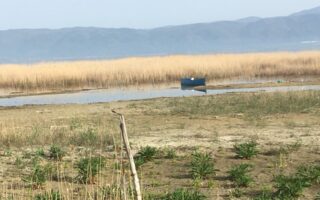Residents of Serifos seek harmonious balance
With its mines shuttered and vineyards abandoned, Iron Island relies heavily on tourism income

To the untrained eye, this may appear as just another Cycladic slope. Beneath a chapel, the lynchets form small balconies. Along the edges, daisies have flourished, and on the distant horizon, one can catch a glimpse of the island of Kythnos. Apart from its privileged view, this land holds more treasures. Here, across 5 windswept acres, the vines of Christos Chrysoloras have firmly taken root. It requires both strong arms and unwavering passion to cultivate this rugged terrain.
On Serifos, also known as the “Iron Island,” grape cultivation served as supplementary income to the once-bustling mining industry. Decades ago, the pits were abandoned before the vineyards. Nowadays, tourism dominates like a monoculture.
‘The island has reached its limit. Its carrying capacity was exceeded long ago’
The 40-year-old winemaker, one of the few locals still active in the primary sector, heavily relies on summer visitors for a substantial portion of his income. However, in recent years, he has grown increasingly apprehensive about the path Serifos is on. “We are a small island, and we all know who is constructing and for what purpose, whether it’s accommodations or holiday homes for short-term rentals,” he remarks. “What is clear is that the island has reached its limit. Its carrying capacity was exceeded long ago.”
His partner at the winery, Yiannis Kontes, recounts how last summer, during peak season, the electricity supply was disrupted for several hours at night in his own village, Panagia, to ensure uninterrupted service in the parts of the island where nearly all tourist activity is concentrated, namely Chora and Livadi. “Everything revolves around the needs of tourism,” he observes.
These developments have sparked reactions. The two winemakers recall the case of Kallitsos, a village that refused a few years ago to connect a newly built country house to the reservoir that supplies their water. “Today, if we allow one connection, tomorrow others will follow,” was the community’s rationale.
Simultaneously, the increasing trend of land sales in recent years seems to be fostering false expectations among some residents. Kathimerini was informed about an inaccessible olive grove, less than half an acre in size, overlooking a ravine. According to relevant regulations, the olive grove was unsuitable for construction and could only be utilized for agricultural purposes. However, the owner was selling it at a premium, hopeful that someone might circumvent the restrictions and convert the old farmhouse on the land into tourist accommodations. He viewed it as an opportunity not to be missed.

As happened in neighboring Sifnos, the proposal by the Elliniki Etairia – Society for the Environment and Cultural Heritage to include the island in the Europa Nostra endangered monuments program ignited considerable debate. Compared to other Cycladic islands, Serifos experiences less tourism and economic activity. Much of the island remains undeveloped. Nonetheless, many locals worry that at the current pace of development, the island’s resources are being depleted.
Construction
According to data from the Hellenic Statistical Authority (ELSTAT), Serifos saw 78 building permits issued during the 2018-2022 period, covering an area of 14,711 sq.m. Topographer Christos Siantrivanopoulos suggests that the rate of building activity is not cause for alarm and does not match that of other islands. He estimates an average of five to six new off-plan structures are erected annually. Data collected by his colleague Achilleas Gazis reveal that 101 off-plan buildings with relevant permits were completed during the 2009-2023 period, with the majority situated in the southeastern part of the island. This contrasts with the 125 constructions recorded between 1978 and 2008.
“They issue the permits, but not all of them actually build. They issue them with the aim of exploiting the property because, given Greece’s legal system, what is applicable today may not be the case tomorrow,” notes Siantrivanopoulos, highlighting that primarily villas are being developed. “There is indeed demand for land, but the best properties have already been purchased.”

Similarly, civil engineer Yannis Sakellariou remarks that over the past three years, Serifos has increasingly drawn attention in the real estate market. “Serifos was previously overlooked. However, there has been a recent shift, perhaps due to other islands also reaching saturation. We’re witnessing larger investments, covering larger areas and involving higher budgets,” he observes. He disagrees with labeling the situation as “overconstruction” on this island specifically. “While construction is on the rise in the more accessible parts of Serifos, it cannot be likened to the levels seen on Paros or Sifnos. There’s potential for overbuilding in the future, and it would be wise to address that,” he adds.
Eleni Chrysolora, a notary and mortgage officer for four decades, points out that urban planning issues on Serifos are more complex compared to neighboring islands. She mentions settlements that were never officially delineated despite efforts by local authorities, as well as the lack of stringent urban planning oversight. Similar to Sifnos, regulatory checks on Serifos are conducted by the understaffed building agency based on the island of Milos.
Going underground
Debate on the island has recently centered on underground constructions. Some locals argue that while these constructions may have the necessary permits, they distort the landscape and diverge from the island’s character and architectural identity. An environmental impact study has been conducted for the construction of a four-star, 93-bed capacity underground hotel near Ganema beach. Notably, its location falls within the boundaries of a Natura 2000 protected area.

According to the 263-page study reviewed by Kathimerini, the estimated construction cost is 5 million euros. The complex will comprise 10 underground structures connected by an 80-meter-long above-ground cable car. In addition to a communal pool, each of the 31 rooms will feature a private swimming pool. Additionally, connections to the municipal water and electricity networks are planned. The developers assert that there are no “negative cumulative action problems” in the area and that the investment will be executed “with respect for the natural environment and landscape.”
Architect Flora Kataleifou, who has extensive experience working on the island, notes an increase in permits for underground buildings. She emphasizes the necessity of conducting geotechnical studies beforehand to ascertain the subsoil composition, thus enabling an accurate assessment of required interventions and their potential impacts – a procedure whose consistency across cases is uncertain.
“We endeavor to strike a balance between environmental preservation and investor interests,” she remarks. “We aim to discourage larger clients seeking amenities like pools, and in at least two instances, we have succeeded. Our rationale is that such additions would burden the island.”
Her colleague, Anna Skiada, underscores the absence of a zoning plan, which allows private individuals to establish “small settlements” anywhere. “The challenge lies in achieving development that harmonizes with the landscape’s character. Projects of this nature will necessitate water supply and waste management solutions,” she emphasizes.
Incomplete dam
Observing these developments and considering the preceding drought, Serifos Mayor Konstantinos Revinthis expresses concern that the island may face water shortages this summer. “In previous years, we strained the water table, but with the limited rainfall, we managed. This year will be challenging,” he remarks.
 Last year, he initiated a campaign by distributing informative leaflets to businesses and clubs, urging responsible water usage. Notably, 38% of water meters and 78% of consumption are concentrated in the port area, specifically in Livadi and Livadakia, where the majority of tourist establishments are situated. The mayor also highlights that water demand nearly doubles in Chora during the summer due to short-term rentals.
Last year, he initiated a campaign by distributing informative leaflets to businesses and clubs, urging responsible water usage. Notably, 38% of water meters and 78% of consumption are concentrated in the port area, specifically in Livadi and Livadakia, where the majority of tourist establishments are situated. The mayor also highlights that water demand nearly doubles in Chora during the summer due to short-term rentals.
Serifos does have a dam – a topic of discussion among island residents. A poorly maintained road, riddled with potholes, leads to the facility, capable of holding 700,000 cubic meters of water. However, its current water level is considerably lower. Construction of the reservoir commenced in 1998 with funding from the Ministry of Agriculture, primarily intended for irrigation purposes. However, it remained unfinished.
“Completed” in 2005, the dam never functioned properly due to unfinished accompanying works. Notably, it lacks a spillway for excess water and a rapid refinery essential for supplying water to the island.

According to the former mayor of Serifos, in 2010, funds for the rapid refinery were secured, but the project faced delays due to an environmental study request. The current mayor says that studies are under way to address these long-standing issues.
However, for decades, the dam has been utilized paradoxically. Water collected there is used to replenish the aquifer, and is then extracted through boreholes. “Approximately 80% is lost in this process,” states Revinthis. “With a rapid refinery, we could likely better endure periods of water scarcity.”
He is currently serving his second term in the Municipality of Serifos. Upon his initial election, he became the youngest mayor in Greece. When we met him in late February in Chora, the small square outside his office resembled a deserted movie set. There are scarcely more than 10 residents left in the surrounding houses, with no permanent human presence in three quarters of the settlement, allowing one to freely wander through the narrow, whitewashed alleys.
“There are two extremes on the island: In winter, we witness desolation,” remarks the mayor, illustrating this with a typical example: the period a few days before and after the Christmas holidays, when not a single restaurant remained open on Serifos. “We are heavily reliant on tourism, creating a monoculture. The primary sector, with few exceptions, is neglected. The people of Serifos must determine the type of development that best suits us. If faced with another pandemic, would we be able to withstand it? We are heavily dependent on tourism, and without it we lack an alternative,” he states.
Sustainability study
The Municipality of Serifos has enlisted the expertise of Ioannis Spilanis, a professor at the University of the Aegean and director of the Local and Island Development Laboratory (ETNA), to conduct a sustainability study. He highlights the significant seasonal disparity, which poses challenges beyond the residents’ control. “Serifos lags behind other islands that have undergone substantial transformation. However, it stands at a critical crossroads – whether it will cross to the other side or remain as is,” he observes. “The winter lull drives people away, rendering the island demographically and socially unsustainable.”
 Population statistics indicate a decline on the island. From 2010 to 2019, 62 births and 141 deaths were recorded. “Winter here feels deserted,” remarks Dimosthenis Diamantis, a 40-year-old beekeeper who chose to settle in Serifos in 2013, contrary to the general trend. His wife works as a kindergarten teacher. We met him at the property where he keeps his beehives, and were greeted by a rooster and two fledgling hens. The plot overlooks the hill where Chora is perched.
Population statistics indicate a decline on the island. From 2010 to 2019, 62 births and 141 deaths were recorded. “Winter here feels deserted,” remarks Dimosthenis Diamantis, a 40-year-old beekeeper who chose to settle in Serifos in 2013, contrary to the general trend. His wife works as a kindergarten teacher. We met him at the property where he keeps his beehives, and were greeted by a rooster and two fledgling hens. The plot overlooks the hill where Chora is perched.
“There’s considerable pressure on the primary sector from tourism. We must tread carefully to preserve the landscape, but our rural incomes rely on tourism, as that’s where our products find buyers,” he explains.
The estimated maximum capacity for visitors on Serifos is 9,000, about 7.3 times the island’s population, reflecting the strain during the tourist season, according to Spilanis.
 Giorgos Nikolaou, chairman of the Merchants and Professionals Association of Serifos, acknowledges the traffic issue along the road connecting Livadi and Chora during the summer but notes that the influx is concentrated mainly in August. “It’s prudent to be concerned; prevention is better than cure,” he says. “But tourism and construction are the twin pillars of our island’s economy.”
Giorgos Nikolaou, chairman of the Merchants and Professionals Association of Serifos, acknowledges the traffic issue along the road connecting Livadi and Chora during the summer but notes that the influx is concentrated mainly in August. “It’s prudent to be concerned; prevention is better than cure,” he says. “But tourism and construction are the twin pillars of our island’s economy.”
On the coastal road of Livadi, Stamatina Koukaki prepares the day’s dishes in the kitchen of the taverna she runs with her husband. The first customers usually arrive when construction activities cease, predominantly crew members from other parts of Greece due to the island’s insufficient local workforce. “The reality lies somewhere in between,” she observes. “We experience challenges for a few weeks in August; it’s not overtourism throughout the season. However, our infrastructure isn’t adequate to support the influx of visitors.”
The significant impact of tourism, albeit short-lived during the season, affects individuals differently depending on their occupation.
Athanasios Kontaris settled on Serifos in 2018 as the sole qualified doctor on the island. He witnessed a surge in demand for health services during the summer months, leading to strenuous working conditions. “This posed serious risks,” he recalls. “I’d be working late into the night, only to receive calls for emergencies shortly after.”

He long advocated for staffing the regional clinic, but to no avail. He attempted to mobilize volunteers, feeling, as he puts it, like Don Quixote. Despite not wanting to leave the National Health System (ESY), he decided to resign. However, his persistence and efforts eventually paid off. He received assurances that reinforcements would be dispatched, prompting him to withdraw his resignation. As of this year, the practice boasts three rural doctors and two nurses.
One of the latest additions to the team is pediatrician Christos Pavelis. He relocated to the island with his wife, a midwife, from Preveza, in northwestern Greece. Until recently, there was no such specialized care available during the winter months for the 200 children on the island. “The Greek state will only assist you if you decide to put pressure on it,” he remarks.





